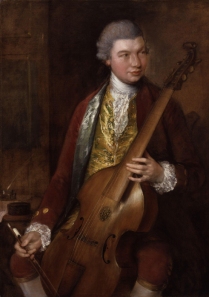Tags
Boulder Bach Festival, Brandenburg Concerto no. 3 in G Major, Brandenburg Concerto no. 5 in B flat Major, Brandenburg Concertos, Carl Friedrich Abel, Christian Ferdinand Abel, concerto, continuo, da gamba, Diego Ortiz, Erbarme dich mein Gott um meiner Zähren Willen, First Congregational Church, frets, harpsichord, Leipzig, ornamentation, rebab, Rick Erickson, siciliano, sonata, sonata da chiesa, Sonata in D Major, Sonata in G Major, Sonata in G minor, Sonatas for Viola da Gamba and Harpsichord, St. Matthew Passion, Trattado de glosas, vihuela de mano, viol, viola da gamba, Weimar, Zachary Carrettin

Carl Friedrich Abel
Although the circumstances behind Bach’s composition of three Sonatas for harpsichord and viola da gamba (BWV 1027-29) are unknown, recent research indicates that they were most likely written in the early 1740’s, when the greatest virtuosos of the viola da gamba were long a thing of the past. No original source combines all three sonatas into a cycle, but a single score of the Sonata in G Major (BWV 1027) that details performance instructions for ornamentation and articulation supports the idea that Bach wrote the sonatas for Carl Friedrich Abel, the son of Cöthen colleague Christian Ferdinand Abel, for performance during his 1737-1743 sojourn in Leipzig.
The viola da gamba emerged in Spain during the fifteenth century, perhaps as a hybrid between the North African rebab and the Spanish vihuela de mano. With six strings and a fretted fingerboard, this novel instrument in various sizes traveled quickly to Italy and was soon being produced by master luthiers throughout the Continent and England. Bach became acquainted with the North German instruments owned by Johann Ernst von Sachsen-Weimar, and an inventory of Bach’s possessions shows that he owned a hundred-year-old English “viol” at the time of his death.
A description of a harpsichord collaborating with a viola da gamba can be found in the Trattado de glosas published by Diego Ortiz in 1533, but instead of the harpsichord simply introducing themes to the viol for further elaboration, Bach calls for the harpsichordist’s left hand to play basso continuo while the right hand acts as a melody instrument.
The Sonata in G Major is a reworking of a Sonata for two flutes and continuo (BWV 1039). Written in the four-movement (slow-fast-slow-fast) sonata da chiesa form, Bach infuses this sonata with the newer gallant style and engages all three voices in intense contrapuntal conversation.
The Sonata in D Major (BWV 1028) is the most virtuosic of the three sonatas for the viola da gamba, although the harpsichord remains at least an equal partner throughout. Again in four movements, the opening adagio presents an arioso-like melody shared between the two instruments, and he following allegro features a melody full of lively rhythms and exuberant momentum. The third movement, an andante, presents a siciliano melody reminiscent of Erbarme dich, mein Gott, um meiner Zähren Willen! from the St. Matthew Passion (BWV 244), and the final movement includes an extended, cadenza-like harpsichord solo similar to the one in the Brandenburg Concerto no. 5 in B flat Major (BWV 1050).
The Sonata in G minor (BWV 1029) differs from the other two sonatas in that it is in the three-movement Italian concerto form. From the outset, the harpsichord’s accompaniment resembles the orchestral texture of the Brandenburg Concerto no. 3 in G Major (BWV 1048). In the adagio, Bach exploits the viola da gamba’s capacity to soar in a movingly, tender way, and the final allegro deftly handles a profusion of themes.
Boulder Bach Festival music director Rick Erickson will join concertmaster Zachary Carrettin in a performance of the entire Sonata in G minor at a Benefit Concert at 6:30pm on 24 May 2012 at First Congregational Church in Boulder.
